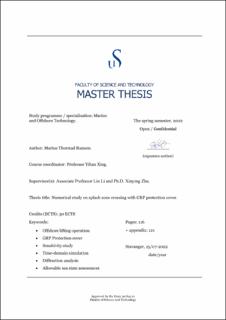| dc.description.abstract | For oil and gas fields moving further offshore, it has been more common to use a subsea production system or a combination of rig and subsea structures. These subsea structures must be overtrawlable if they are not marked with a buoy or vessel. One solution for overtrawlable subsea structures is to use a protection cover. This study focuses on GRP pipeline protection covers, which are highly weather-sensitive due to their low weight and large surface area. Installation of subsea protective covers typically involves overboard, lowering through the splash zone, and lowering to the seabed. This study will focus on the lowering through the splash zone, which is usually considered one of the most critical phases of a deployment operation. The hydrodynamic property for the cover is calculated based on DNV-RP-H103 simplified methods [1].
The vessel’s properties are collected with a diffraction analysis program that calculates the responses and loading for wet bodies using potential flow theory. Hence, body results are generated for: damping, added mass, displacement RAOs, and load RAOs. In addition, the calculated pressure in the fluid will yield the sea state RAOs for the fluid pressure. The vessel was then implemented into the numerical time-domain program with the cover.
For the numerical methods, two sensitivity studies are conducted to evaluate the number of wave seeds and vessel motion to be applied to assess sea states. First, the numbers of seeds selected were based on the extreme values for the sling tension. Then, analyzing the extreme values with a statistical method and the cumulative average for minimum and maximum tension. The extracted results indicated that 30 seeds were enough to yield reliable predictions of the sea states. The same procedure was applied for the vessel motion as for the number of wave seeds. In addition, the simulation demo file was closely investigated to observe any differences between the motions. From the extracted extreme values, the difference between the motion where slightly more conservative for the coupled motion. However, the uncoupled vessel motion was selected to assess the allowable sea states. The uncoupled motion would better represent the real-life, where for the coupled vessel it was observed large yaw motions for longer wave periods
In the assessment of the sea states, three simulation cases were selected to investigate the hydrodynamic forces during the splash zone crossing. Firstly, the different lifting angles of the cover made it possible to adjust the waterplane area. Secondly, evaluate the vessel position for wave directions of 165 and 180 degrees. Lastly, use the vessel to disrupt the incoming waves generating a shielding effect for the cover. Concerning the operational criteria, the extreme values were fitted to a Gumbel probability paper to assess the allowable sea states.
The results indicated that the shielding effect on the cover would yield the best applicable sea states for all tested methods. For the different tested lifting angles of the cover. The cover with the lowest waterplane area resulted in the highest sea states due to lower hydrodynamic forces on the cover. Lastly, for the two tested wave directions. The vessel for head waves yielded slightly better allowable sea states. The increased roll motion for the wave direction at 165 degrees resulted in larger slamming loads and lower sling tensions for the cover. | |
